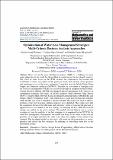| dc.contributor.author | Kadenge, Maselle Joseph | |
| dc.contributor.author | Masanja, Verdiana Grace | |
| dc.contributor.author | Mkandawile, Mashaka James | |
| dc.date.accessioned | 2020-06-11T08:00:48Z | |
| dc.date.available | 2020-06-11T08:00:48Z | |
| dc.date.issued | 2020-02-29 | |
| dc.identifier.uri | http://dx.doi.org/10.22457/jmi.v18a9166 | |
| dc.identifier.uri | https://dspace.nm-aist.ac.tz/handle/20.500.12479/781 | |
| dc.description | This research article published by the Journal of Mathematics and Informatics, 2020 | en_US |
| dc.description.abstract | Water loss in the water distribution systems (WDS) is a challenge to many
water authorities in the world but the problem is crucial in the less developed countries.
The effect of water losses in the WDS includes the reduction in the revenue and
availability of water, interruption in the quality of water, and inflation of the operation
and maintenance cost of the water authorities. Using data from the Moshi Urban Water
Supply and Sanitation Authority (MUWSA) Tanzania, an assessment of strategies used
for water loss management (WLM) was carried out through an integrated model of Multi-
Criteria Decision Making (MCDM) and Integer Linear Programming (ILP) which is an
optimisation technique. The family of MCDM methods, Multi-Attribute Value Theory
(MAVT), Simple Multi-Attribute Rating Technique Exploiting Ranks (SMARTER), and
Simple Additive Weighting (SAW) were employed to assess and prioritise the strategies
while the ILP was used to formulate a decision model. The model was used to select a
portfolio of the best strategies. Sixteen strategies were identified. The results show that
the comparison between the bulk meter and customers’ meter on detecting the physical or
apparent losses was ranked as the best strategy in managing the loss while the network
zoning was ranked as the worst strategy. The model selected thirteen out of sixteen
strategies to form the portfolio of the best strategies to be employed by the MUWSA for
water loss management. Furthermore, the model was found to be robust as the selected
portfolio of strategies remained the same even when the weights of the criteria were
changed. The developed model in this study will assist the decision-makers to assess,
prioritise and choose the best strategies for reducing or controlling water loss in the
distribution system. | en_US |
| dc.language.iso | en | en_US |
| dc.publisher | Journal of Mathematics and Informatics | en_US |
| dc.subject | Integer Linear Programming | en_US |
| dc.subject | Multi-Criteria Decision Making methods | en_US |
| dc.subject | Water Loss Management | en_US |
| dc.subject | Water Distribution System | en_US |
| dc.title | Optimisation of Water Loss Management Strategies: Multi-Criteria Decision Analysis Approaches | en_US |
| dc.type | Article | en_US |

